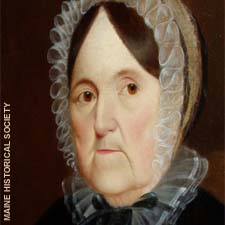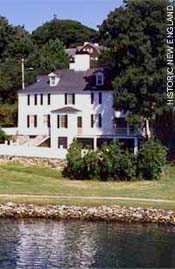| Sally Wood was First Maine Novelist |

SEACOAST LITERARY LIONS
Her name was Sarah Sayward Barrell Keating Wood, but people called her Sally. She signed her first novel "A Woman from Massachusetts" back in 1800 because Maine was still part of the Bay State. She wrote about the secret society of the Illuminati in France 200 years before Dan Brown did the same.
Did Dan Brown Steal Her Novel Idea?
Sarah "Sally" Sayward Barrell Keating Wood
(1759 – 1855)
Maine's first Novelist
Saarah Sayward Barrell Keating Wood, the earliest fiction writer from the state of Maine, was born in her grandfather’s house in York. He was Judge Jonathan Sayward, one of Maine’s wealthiest and most prominent men, a Loyalist merchant, and representative of York County in the Massachusetts General Court.
 At 19, Sally married Richard Keating, who had been a clerk in Judge Sayward’s office. The couple lived in across the path in a house given to them as a wedding present by Sally’s grandfather. Their three children were born in this house. The youngest was born four months after Richard Keating died of an illness in 1783.
At 19, Sally married Richard Keating, who had been a clerk in Judge Sayward’s office. The couple lived in across the path in a house given to them as a wedding present by Sally’s grandfather. Their three children were born in this house. The youngest was born four months after Richard Keating died of an illness in 1783.
For the next twenty-one years Sally Keating lived as a widow in this house, where she brought up Elizabeth, Sally and Richard junior. Until Judge Sayward’s death in 1797 Sally continued to participate in her grandfather’s social life. Together they received the most prominent visitors from Boston and elsewhere, including John Adams, the Sewalls and the Hancocks, who had business and political interests in York.
During her long period of widowhood Sally began to write. She published four novels, under the pen name "A Lady from Massachusetts." It is thought that she also submitted articles anonymously to the Massachusetts Magazine and other periodicals.
Julia and the Illuminated Baron, her first novel, was published in Portsmouth in 1800. It references the activities of the secret society of the Illuminati in France - an interesting coincidence given today’s craze for Dan Brown’s novels, including Angels and Demons, which also refers to the secret activities of the Illuminati. From all accounts of her writing, it was not as fascinating "a read". Sally’s style has been labeled "gothic, highly overwrought, sentimental and moralizing." But the Dictionary of American Biography DAB) notes that Sally’s novel "has the distinction of being perhaps the most thoroughgoing example in American literature of the Gothic romance of the Radcliffe type."
Dorval: or the Speculator (1801) and Amelia, or the Influence of Virtue, an Old Man’s Story (1802) were both published anonymously in Portsmouth. Dorval deals with land speculation in Georgia, but is rambling and difficult, if not impossible to read today. Finally, in 1804 she published Ferdinand and Elmira: A Russian Story. The DAB describes it as a "fanciful tale of tangled loves, mistaken identity, and overworked coincidence." On the other hand Herbert Ross in his introduction to the reprinting of Tales of the Night wrote that she, "disclaiming any pretentions of being a Learned Lady, …asserted that her abilities were too scanty to enable her ‘to undertake the labors of history, philosophy, and religion’ or to attain ‘the sublime heights of poetry.’ To Ross this recognition of her abilities seemed endearing, especially when she noted that "not one social or one domestic duty has been sacrificed or postponed by her pen."
After her long widowhood, Sally Keating married General Abiel Wood, a wealthy widower from Wiscassett, Maine in 1804 and lived in that town until after his death in 1811. She eventually moved to Portland, Maine, where she resided till about 1830. Madam Wood, as she was then known, published her last tome under her new pen name "A Lady of Maine." The first volume of this work Tales of the Night was published by Thomas Todd of Portland in 1827. It contains two narratives: "Storms and Sunshine; or the House on the Hill" and "The Hermitage, or Rise of Fortune." Unlike her earlier novels, the first story is set in Maine and begins with a blizzard, which endangers the lives of the heroine and her family. Describing the weather in Maine she wrote that "a frost had followed upon the rain and every tree was hung with a thousand glittering icicles, that shone in the rays of the sun and out-dazzled the most superb diamonds." Madam Wood changed her sentimental gothic style to what John Neal in his review in The Yankee (Jan. 16, 1828) characterized as "about as good as we generally meet with among the novels of the age."
The second volume never appeared. Madam Wood is said to have destroyed her manuscript after she read the novels of Sir Walter Scott. She became a celebrity in Portland, recognizable by her eccentric old-fashioned dress and high turbans, but also by the reputation of her keen mind.
In 1830 she moved to New York City, where her son, Captain Richard Keating, was posted to his new assignment. Tragically in the winter of 1833 he died with all his crew when his ship was crushed in the night by floating ice in New York harbor. The following summer, after this most painful loss, Madam Wood returned to Kennebunk, Maine, where she lived with her granddaughter. Even during her last years, she continued to write articles and reminiscences for her friends and family.
Portrait courtesy Maine Historical Society and picture of Sayward=Wheeler House Museum from Historic New Englamd.
